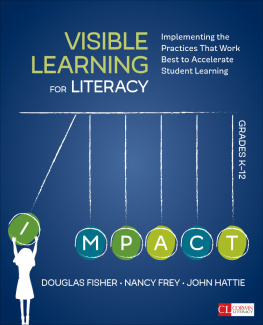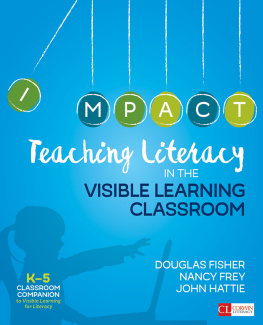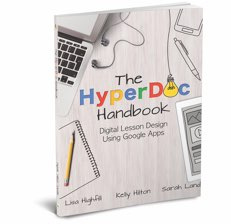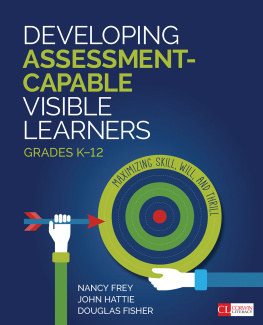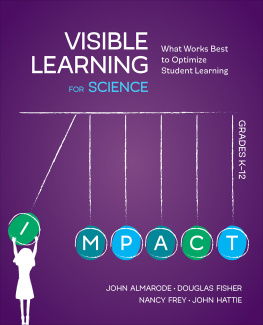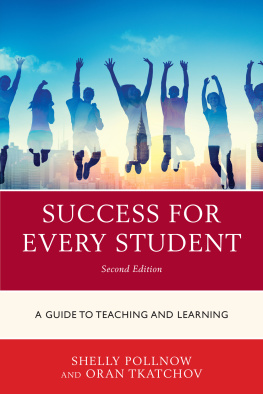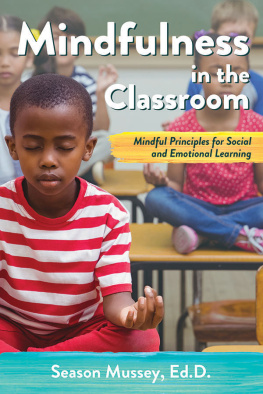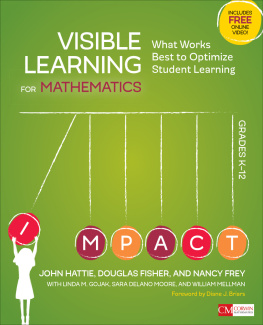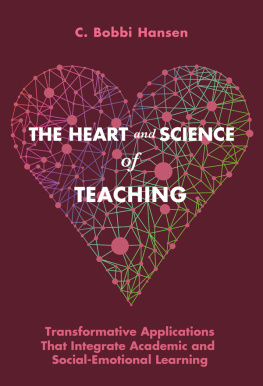
Table of Contents
More Praise for Visible Learners
Visible Learners is the most comprehensive approach to the values of documentation and how to go about it yet published. This volume makes clear that documentation can serve a wide range of important purposes for learners and their teachers, their families, and even their larger communities. The authors' discussion of the positive uses of documentation in connection with formal state standards is not only very timely, but also very helpful and practical. This book should be available to all teachers of all ages and subjects, not only during their training, but also throughout their work with our children.
Lilian G. Katz, Ph.D., Professor Emerita & Clearinghouse on Early Education and Parenting, University of Illinois
This smart book begins with a series of stories about reciprocal learning by young people at different levels of schooling. Next it proposes that readers analyze those stories in terms of multiple insights gained from documentation, which can make learning, whether by individuals or groups, visible, and can indicate how this learning can be further sustained. The authors then face head-on the questions now so frequently asked about how documentation can support standard-based practice. Leaving no stone unturned, the authors construct on the basis of their extensive experience, a practical guide to structures, strategies, and tools for fostering learning in groups through documentation. Where the authors suggest that readers refer to the earlier book they produced together with Reggio Children, Making Learning Visible, I instead would insist that readers regard it as fundamental for understanding the principles that underlie this generous new work.
Lella Gandini, U.S. Liaison for the Dissemination of the Reggio Emilia Approach
With the challenge of preparing all students for college and career readiness and Common Core State Standards, there is agreement on this: students need to be independent, reflective learners, critical thinkers and problem solvers. How do we develop these attributes in students? Visible Learners offers a powerful answer: classrooms dedicated to the process of looking closely at student ideasobserving, documenting and analyzing to improve the quality of student work and understanding.
Ron Berger, Chief Program Officer, Expeditionary Learning
Dedication
For Andrew, Liz, Steve, and Terri for their support
Copyright 2013 by John Wiley & Sons, Inc. All rights reserved.
Cover design by Michael Cook
Cover image: Copyright 2013 by Melissa Rivard
Published by Jossey-Bass
A Wiley Brand
One Montgomery Street, Suite 1200, San Francisco, CA 94104-4594www.josseybass.com
No part of this publication may be reproduced, stored in a retrieval system, or transmitted in any form or by any means, electronic, mechanical, photocopying, recording, scanning, or otherwise, except as permitted under Section 107 or 108 of the 1976 United States Copyright Act, without either the prior written permission of the publisher, or authorization through payment of the appropriate per-copy fee to the Copyright Clearance Center, Inc., 222 Rosewood Drive, Danvers, MA 01923, 978-750-8400, fax 978-646-8600, or on the Web at www.copyright.com. Requests to the publisher for permission should be addressed to the Permissions Department, John Wiley & Sons, Inc., 111 River Street, Hoboken, NJ 07030, 201-748-6011, fax 201-748-6008, or online at www.wiley.com/go/permissions.
The names of the teachers and many of the students have not been changed, though in a few cases pseudonyms are used for students.
Limit of Liability/Disclaimer of Warranty: While the publisher and author have used their best efforts in preparing this book, they make no representations or warranties with respect to the accuracy or completeness of the contents of this book and specifically disclaim any implied warranties of merchantability or fitness for a particular purpose. No warranty may be created or extended by sales representatives or written sales materials. The advice and strategies contained herein may not be suitable for your situation. You should consult with a professional where appropriate. Neither the publisher nor author shall be liable for any loss of profit or any other commercial damages, including but not limited to special, incidental, consequential, or other damages. Readers should be aware that Internet Web sites offered as citations and/or sources for further information may have changed or disappeared between the time this was written and when it is read.
Jossey-Bass books and products are available through most bookstores. To contact Jossey-Bass directly call our Customer Care Department within the U.S. at 800-956-7739, outside the U.S. at 317-572-3986, or fax 317-572-4002.
Wiley also publishes its books in a variety of electronic formats and by print-on-demand. Some material included with standard print versions of this book may not be included in e-books or in print-on-demand. If the version of this book that you purchased references media such as a CD or DVD that was not included in your purchase, you may download this material at http://booksupport.wiley.com. For more information about Wiley products, visit www.wiley.com.
Library of Congress Cataloging-in-Publication Data
Krechevsky, Mara.
Visible learners : promoting Reggio-inspired approaches in all schools/Mara Krechevsky, Ben Mardell, Melissa Rivard, Daniel G. Wilson.
pages cm
Includes bibliographical references and index.
ISBN 978-1-118-34569-6 (pbk.), ISBN 978-1-118-42032-4 (pdf), ISBN 978-1-118-41692-1 (epub), ISBN 978-1-118-67038-5 (mobipocket)
1. Group work in education. 2. Reggio Emilia approach (Early childhood education)
I. Mardell, Ben. II. Rivard, Melissa, 1964 III. Wilson, Daniel G., 1969 IV. Title.
LB1032.K68 2013
372.21dc23
2013006255
Acknowledgments
In keeping with this book's focus on individual and group learning, our work has been inspired and sustained by the contributions of numerous colleagues and organizations. We would like to thank the Atlantic Philanthropies, the Massachusetts Department of Elementary and Secondary Education, and the Barr Foundation for their support in funding Project Zero and pre-K12 teachers and teacher educators in the Boston area. In particular, we are grateful to Angela Covert and Kim Haskins for their vision and commitment to this work. We would also like to thank the Ohio Department of Education for its support of the Making Learning Visible (MLV) work at the Wickliffe Progressive Community School in Upper Arlington, Ohio.
An enormous amount of gratitude goes to the teachers, administrators, and high school students who participated in the MLV seminars: Aaron Levy, Adeleine Rodene, Amanda Van Vleck, Annie Sevelius, Ariela Rothstein, Betsy Damian, Bobbi Rosenquest, Cathy Milne, Char Skidmore, Cheryl Sutter, Chris Bucco, Chris Low, Cindy Snow, Clancie Wilson, Dan Monahan, Danikka Giarratani, David Ramsey, Deb Dempsey, Debi Milligan, Doug Anderson, Ellen Goldberg, Frances Farrell, Gene Thompson-Grove, Gerardo Martinez, Gina Stefanini, Gizelle Dizon, Graciela Hopkins, Heather Moore Wood, Heather Nord, Heidi Lyne, Ian Hamel, Jennifer Hogue, Jill Berg, Joan Soble, Joanne Cleary, Johanna Grochowalski, Jon Hirst, Karen Daniels, Kendra McLaughlin, Kerrie-Lee Walker, Kevin Depin, Kyle Dodson, Lesley Strang, Lin Tucker, Lindy Johnson, Lisa Dittrich, Lisa Fiore, Lori Rivera, Lynn Hurley, Lynn Stuart, Maggie Donovan, Marc Kenen, Maren Oberman, Marguerite Hicks, Marina Boni, Masami Stampf, Melissa Tonachel, Molander Etienne, Nicole Chasse, Pam Richardson, Phyllis Bretholtz, Rachel Hayashi, Rachelle Milord, Rawchayl Sahadeo, Sarae Pacetta, Sarah Fiarman, Sarah Mayper, Sevan Marinilli, Stephanie Cox Suarez, Tassia Thomas, Tavia Mead, Tina Blythe, Todd Curtis, Una MacDowell, Yvonne Young, and Zoe Cohen. We are honored to be your colleagues and deeply grateful for your dedication to exploring new possibilities for teaching and learning. Each of you contributed enormously to our understanding of how to put these ideas into practice in US schools across the grades. Without you, there would be no book.
Next page

